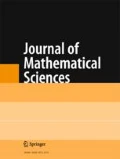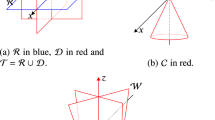Abstract
Let \(\dot q = f(q) + ug(q)\) be a smooth control system on a three-dimensional manifold. Given a point q 0 of the manifold at which the iterated Lie brackets of f and g satisfy some prescribed independence condition, we analyze the structure of a control function u(t) corresponding to a time-optimal trajectory lying in a neighborhood of q 0. The control turns out to be the concatenation of some bang-bang and some singular arcs. More general optimality criteria than time-optimality are considered. The paper is a step toward to the analysis of generic single-input systems affine in the control in dimension 3. The main techniques used are second-order optimality conditions and, in particular, the index of the second variation of the switching times for bang-bang trajectories.
Similar content being viewed by others
REFERENCES
A. A. Agrachev, “On regularity properties of extremal controls,” J. Dyn. Control Systems, 1, No. 3, 319–324 (1995).
A. A. Agrachev and R. V. Gamkrelidze, “A second-order optimality principle for a time-optimal problem,” Math. USSR Sb., 29, No. 4, 547–576 (1976).
A. A. Agrachev and R. V. Gamkrelidze, “Symplectic geometry for optimal control,” in: Nonlinear Controllability and Optimal Control (H. J. Sussmann, Ed.), Pure Appl. Math., 133, Marcel Dekker (1990).
A. A. Agrachev and M. Sigalotti, “On the local structure of optimal trajectories in ℝ3,” SIAM J. Control and Optimization (in press).
H. J. Kelley, R. E. Kopp, and H. Gardner Moyer, “Singular extremals,” in: Topics in Optimization, Academic Press, New York (1967), pp. 63–101.
I. A. K. Kupka, “The ubiquity of Fuller’s phenomenon,” in: Nonlinear Controllability and Optimal Control (H. J. Sussmann, Ed.), Pure Appl. Math., 133, Marcel Dekker (1990).
L. S. Pontryagin, V. G. Boltyanski, R. V. Gamkrelidze, and E. F. Mischenko, The Mathematical Theory of Optimal Processes, Wiley, New York (1962).
H. Schättler, “Regularity properties of optimal trajectories: Recently developed techniques,” in: Nonlinear Controllability and Optimal Control (H. J. Sussmann, Ed.), Pure Appl. Math., 133, Marcel Dekker (1990).
H. J. Sussmann, “Time-optimal control in the plane,” in: Feedback Control of Linear and Nonlinear Systems, Lect. Notes Control Information Sci., 39, Springer-Verlag, Berlin (1985), pp. 244–260.
H. J. Sussmann, “A weak regularity for real analytic optimal control problems,” Bibl. Rev. Mat. Iberoam., 2, No. 3, 307–317 (1986).
H. J. Sussmann, “The structure of time-optimal trajectories for single-input systems in the plane: The C ∞ xnonsingular case,” SIAM J. Control Optimization, 25, No. 2, 433–465 (1987).
M. I. Zelikin and V. F. Borisov, Theory of Chattering Control with Applications to Astronautics, Robotics, Economics, and Engineering, Systems and Control: Foundations and Applications, Birkhäuser, Boston (1994).
Author information
Authors and Affiliations
Additional information
Translated from Sovremennaya Matematika i Ee Prilozheniya (Contemporary Mathematics and Its Applications), Vol. 9, Suzdal Conference-3, 2003.
Rights and permissions
About this article
Cite this article
Sigalotti, M. Regularity properties of optimal trajectories of single-input control systems in dimension three. J Math Sci 126, 1561–1573 (2005). https://doi.org/10.1007/s10958-005-0044-z
Issue Date:
DOI: https://doi.org/10.1007/s10958-005-0044-z




